Steady progress of transformation
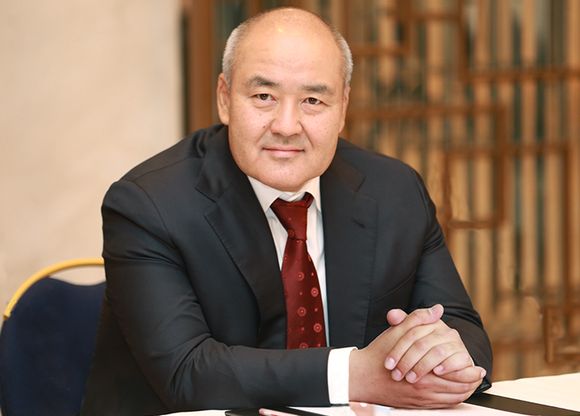
582
27 September 2016
Umirzak Shukeyev serves as Chairman of the Management Board at Samruk-Kazyna SWF since December 2011 – for almost five years. Holding’s external image has undergone transformation within this period: all development institutions were separated fr om it and the company withdrawn all of its shares fr om commercial banks. Now it was the time for some structural changes. Some of Mr. Shukeyev’s colleagues directly link the launch of the transformation programme to him.
The idea of the holding’s transformation into an active portfolio investor, and the EVA index, and the word "transformation" itself were not new for Samruk-Kazyna. The previous strategy for Samruk written in 2008 contained all these ideas. However, it took eight years and three changes of leaders to go on to the implementation of this strategy.
Change of motivation
– What prerequisites for the transformation could you emphasize as fundamental?
– The holding was formed by consolidating a number of production companies: KazMunayGas, Kazakhstan Temir Zholy and others. Samruk-Kazyna was supposed to become the management company for these national companies similar to Temasek and Khazanah. However, the consolidation of all companies turned out to be a mechanical operation. Corporate governance and culture, procedures and mentality in these companies, technology remained the same, with roots from the Soviet Union. Rules, regulations and technology there has not changed for decades. It is clear that hoping these companies would transform only because they were consolidated under a single management company was nothing but unrealistic expectations. So now, it is time to make structural changes in these national companies.
We studied the experience of similar companies and concluded that changes must take place in three directions. The first direction: the people, the quality of the staff, especially the management of the companies. The holding employs 325 thousand people, 26 thousand of them are administrative staff. Out of these 26 thousand managers, 8000 are top-level decision makers. We must focus on them. They should have exactly the same knowledge, skills and motivation as their colleagues working in international companies.
The process has started and hit stride and passed a point of no return
The second direction was the business processes. Each employee performs a specific set of operations: someone is responsible for monitoring, someone for analytics, while others give direct orders. Laws, government resolutions, rules, policies, regulations regulate the activities of each. All of these procedures accumulated in our subsidiaries throughout decades, and often contradicting one another. An employee often goes around in circles, trying to faithfully perform some operation. And it is clear that such work is not effective. Therefore, our task is to conduct an audit of these documents, to eliminate unnecessary rules and then generate a new set of regulations. It is a routine work, we need to look into every business operation and process. For example, we have five levels of business processes. Samruk-Kazyna corporate centre has 190 people working on two thousand business processes. We looked into all of these processes, audited and ‘straightened’ them out.
And the third direction is technologies. In this context, we are talking about processing and management technologies. The importance of IT is growing among processing technologies: the quality of databases, hardware, licenses. Samruk-Kazyna still has no unified policy in this area. Each of the 600 companies used to purchase the software and hardware that they needed, from suppliers whom they wanted. We decided to centralize the purchases. Due to this, we were able to save 200 billion tenge in purchasing SAP software for the next five years (until 2020).
The holding had an idea that each branch company operates by its own rules, that each of them has its own unique features. However, in terms of management technologies, they are all very similar from sector to sector. According to our analysis, 80 percent of them are common, and only 20 are sector-specific. Features such as treasury, procurement, planning and investment are the same. With this in mind, we have developed standards for the implementation of support functions common for all companies: reference models – turned out to be 10 of them and we provided our companies with them, so that they could adapt these models. In general, the transformation’s effect is estimated to be around 1.4 trillion tenge. This is huge, considering that the net profit of Samruk-Kazyna JSC amounted to 305 billion tenge last year.
- What is the complexity of the transformation?
- This is a long-term, routine work, which implies a major change in belief systems of managers. And it is hard to understand for an outside observer. But I am sure that this is the path we should follow if we want to become an international company, competitive like Temasek, Mubadala, Nissan, Toyota and others. Changing people is the hardest job. The Temasek did this job in 15 years, Khazanah started in 2004 and continues to this day.
- What was the alternative to the transformation programme?
- There was no alternative. The problem was that after the creation of Samruk-Kazyna we had no idea how to manage it. But as an asset that brings income, we directed it either in one direction and then in another. For example, we witnessed the crisis, and began functioning as the government agent for the distribution of anti-crisis funds: our job was to pull out banks and construction companies from the downturn, purchased some assets, invested in others, including those that were not profitable. The Fund’s value started to decrease, because of this. And if we would have continued that way then many national companies would have gone bankrupt, we really were close to that. Without transformation, at best, we would be constantly at risk. And, of course, there would be no growth at all.
However, we were able to determine the goals. Samruk-Kazyna Fund is here to efficiently manage the existing assets, and invest its profits in new high-yielding projects. Therefore, the Fund must transform from its role of a passive shareholder to the role of an active investor.
- Over the past 10 years, this is the third major programme for reforming the structure of state-owned assets, merging and then dividing the holding in order to improve efficiency. What positive and what negative changes resulted from the previous structural reforms?
- The Samruk-Kazyna Fund was established in 2008. Back then, there was some confusion. Banks, development institutions were incorporated in the Fund, which of course, was wrong. We unbundled the development institutions into Baiterek, and part of the assets transferred under ministries and shares in the banks were just sold. In my opinion, Samruk-Kazyna was supposed to become an industrial holding company that seeks to grow into a financial holding company. Khazanah is an industrial holding, which has a controlling stake in a number of companies, while investing in new projects. Temasek is a financial holding company, which acquires non-controlling interests in a variety of projects around the world. Our current goal is Khazanah, long-term goal is Temasek.
The current structure of the holding is best, in my opinion. But it is the upper level and in the lower there are number of assets that need to be privatised, merged with others or removed. In two years, we have already sold about 500 non-core assets. The current privatisation programme includes 216 assets: 44 large and 172 small and medium. One asset out of 44 sold and the second one is for sale, asset disposition methods for 127 out of 172 are being coordinated, 33 sold, some assets were liquidated, 12 assets are being reorganised and another 23 are in electronic auctions. As a result, we need to reduce the number of companies from 600 to 300 by the end of 2017. But can you imagine how hard it is? Each of these companies have a chief, the chief has a bunch of links, and there is a huge resistance. We need to reduce the number of management levels from nine to four.
Strong Boards
- What changes in holding’s internal processes will occur during the transformation?
- We have adopted a corporate governance code that focuses on the best of the OECD standards, and that is a trendsetter in this area. We worked directly with the central office of the OECD upon developing the Code. We will manage our subsidiaries through the boards of directors, without direct interference in operational activities. Independent directors should make half of the boards of directors. We should not be engaged in a constant guardianship, micromanagement. Our task is to set KPIs for the management team, and these managers should regularly report how they perform and follow these indicators.
- Privatising blocks of shares in national companies is one of the key elements of the transformation. What was the reason to sell these shareholdings following the Fund’s withdrawal from of a number of small assets?
- We need to privatise non-core companies as well as those included, as we say, within the IPO scope. The latter should be fixed and the subsidiary company itself must go public. We associate this process with the launch of the Astana International Financial Centre in 2017. Shares of our companies will be available there.
- What expectations do you have regarding the results of privatisation? Do you have any image of a perfect investor? Is he a foreign or local? Portfolio or direct investor?
- We have studied privatisation processes in 30 countries. The collective opinion, taking into account some recommendations from the BCG – our advisors is as follows: foreign investors should acquire one third of the assets, another third by joint companies, and one third by local investors. We believe that portfolio investments will become more preferable as soon as our subsidiaries will go public.
Different atmosphere
- At the same time, the fund is striving to become a strategic investor. For how long and wh ere does it plan to invest in? Is it ready to invest more actively in international assets? Are there any plans to hand over the issues of promoting priority sectors to development institutions?
- We have identified several priorities and they are, basically, coincide with the State Programme for industrial-innovative development for 2015-2019. In accordance with our country's potential, we must invest in mining projects. But, to avoid interfering with private businesses, we are aiming to invest in projects that are out of their interests: big in size, but hard to master. For example, one of the world's largest zinc deposits Shalkiya. The difficulty with it is that the elements contained in the ore composition do not allow using traditional methods of development. It is interesting that private investors owned the mine, but they could not find the proper technology and then they sold it to us. Our engineers at Tau-Ken Samruk successfully found one. This fall, we are going to set up a loan agreement with the European Bank for Reconstruction and Development, and begin to build a mining and processing plant. Thus, we work on large deposits that we cannot ignore in terms of our national interests and private investors cannot afford. The ultimate goal of participation in such projects is to bring make these companies public and then sell.
Another priority area is the chemical industry. Production of basic elements, such as polyethylene, polypropylene, butadiene. We can process them into hundreds of products, with additional efforts from small and medium-sized businesses. Owners of private businesses usually cannot afford to participate in such expensive projects. For example, polypropylene project costs 2.6 billion dollars, polyethylene - 5 billion, butadiene - 2 billion. This is what we work with.
We are also making a move into environmental construction, which is not yet interesting for a private investor. The production costs are high: building a square metre of traditional housing costs $800, and for a square metre of environmental housing, you need $1,500. At the same time, we are confident that the project is cost effective, because tenants will save on home heating and other expenses. We are building the Green Quarter, for instance, and 40% of apartments already sold.
- What are the main intermediate results of transformation? For ease of reference, let us divide them into qualitative and quantitative.
- Qualitative: I can physically feel how the organization is changing. Only the best of the former structure are working in the corporate centre now. A wave of young people with Western education or work experience in Western companies have joined our team. And these people are now changing the whole atmosphere in the holding, even the work style, communication style. The quality documents and meetings are at different level now. But I am talking about the corporate centre, and if such changes occur in companies wh ere thousands of people work, it would be equivalent to saying that we find are in completely different dimension.
A rapid victory is what I can emphasize among quantitative results. Without them, there is no transformation. We have 90 of them in six portfolio companies participating in the transformation. They are both in the corporate centre, as well as in subsidiaries: KazMunayGas, Kazatomprom, Kazpost, Samruk-Energo, KTZ and KEGOC.
The project of the century
- There are four years before the end of the transformation programme. What is to be done in this period?
- We have a clear programme, approved by the President, the roadmap. Everything is regulated, and the entire transformation in every organization is divided into projects. For example, there are 24 projects in the head office. There are crosscutting projects, relate to all. And there are some that only impact certain units. We have a fixed start time and the end time for the projects. We only need to continue our work.
- Experience has shown that the main problem with any reforms in the post-Soviet space is that, firstly, the reforms never finalise, and, secondly, the changes are unstable: there is either a rollback or another reform covers the changes. Is it be possible that the programme could be phased out in a situation when, for example, Mr. Shukeyev returns to work in the Government? What guarantees the stability of the results of the Samruk-Kazyna transformation programme?
- I am not the only one working here. The transformation team includes 400 people and they are the best of our employees, our work is well regulated, systematized. Every step is recorded, as well as the history of changes. And I do not think that the fate of these changes depend on one person. The main thing is that this process has started and hit stride and passed a point of no return. I really hope that this reform will be successfully finalised. Because the transformation is more important than any project, such as the construction of a refinery or pipeline. After all, if the company will be built the right way, there will be hundreds of such projects. People who are working here will generate them every day.
The idea of the holding’s transformation into an active portfolio investor, and the EVA index, and the word "transformation" itself were not new for Samruk-Kazyna. The previous strategy for Samruk written in 2008 contained all these ideas. However, it took eight years and three changes of leaders to go on to the implementation of this strategy.
Change of motivation
– What prerequisites for the transformation could you emphasize as fundamental?
– The holding was formed by consolidating a number of production companies: KazMunayGas, Kazakhstan Temir Zholy and others. Samruk-Kazyna was supposed to become the management company for these national companies similar to Temasek and Khazanah. However, the consolidation of all companies turned out to be a mechanical operation. Corporate governance and culture, procedures and mentality in these companies, technology remained the same, with roots from the Soviet Union. Rules, regulations and technology there has not changed for decades. It is clear that hoping these companies would transform only because they were consolidated under a single management company was nothing but unrealistic expectations. So now, it is time to make structural changes in these national companies.
We studied the experience of similar companies and concluded that changes must take place in three directions. The first direction: the people, the quality of the staff, especially the management of the companies. The holding employs 325 thousand people, 26 thousand of them are administrative staff. Out of these 26 thousand managers, 8000 are top-level decision makers. We must focus on them. They should have exactly the same knowledge, skills and motivation as their colleagues working in international companies.
The process has started and hit stride and passed a point of no return
The second direction was the business processes. Each employee performs a specific set of operations: someone is responsible for monitoring, someone for analytics, while others give direct orders. Laws, government resolutions, rules, policies, regulations regulate the activities of each. All of these procedures accumulated in our subsidiaries throughout decades, and often contradicting one another. An employee often goes around in circles, trying to faithfully perform some operation. And it is clear that such work is not effective. Therefore, our task is to conduct an audit of these documents, to eliminate unnecessary rules and then generate a new set of regulations. It is a routine work, we need to look into every business operation and process. For example, we have five levels of business processes. Samruk-Kazyna corporate centre has 190 people working on two thousand business processes. We looked into all of these processes, audited and ‘straightened’ them out.
And the third direction is technologies. In this context, we are talking about processing and management technologies. The importance of IT is growing among processing technologies: the quality of databases, hardware, licenses. Samruk-Kazyna still has no unified policy in this area. Each of the 600 companies used to purchase the software and hardware that they needed, from suppliers whom they wanted. We decided to centralize the purchases. Due to this, we were able to save 200 billion tenge in purchasing SAP software for the next five years (until 2020).
The holding had an idea that each branch company operates by its own rules, that each of them has its own unique features. However, in terms of management technologies, they are all very similar from sector to sector. According to our analysis, 80 percent of them are common, and only 20 are sector-specific. Features such as treasury, procurement, planning and investment are the same. With this in mind, we have developed standards for the implementation of support functions common for all companies: reference models – turned out to be 10 of them and we provided our companies with them, so that they could adapt these models. In general, the transformation’s effect is estimated to be around 1.4 trillion tenge. This is huge, considering that the net profit of Samruk-Kazyna JSC amounted to 305 billion tenge last year.
- What is the complexity of the transformation?
- This is a long-term, routine work, which implies a major change in belief systems of managers. And it is hard to understand for an outside observer. But I am sure that this is the path we should follow if we want to become an international company, competitive like Temasek, Mubadala, Nissan, Toyota and others. Changing people is the hardest job. The Temasek did this job in 15 years, Khazanah started in 2004 and continues to this day.
- What was the alternative to the transformation programme?
- There was no alternative. The problem was that after the creation of Samruk-Kazyna we had no idea how to manage it. But as an asset that brings income, we directed it either in one direction and then in another. For example, we witnessed the crisis, and began functioning as the government agent for the distribution of anti-crisis funds: our job was to pull out banks and construction companies from the downturn, purchased some assets, invested in others, including those that were not profitable. The Fund’s value started to decrease, because of this. And if we would have continued that way then many national companies would have gone bankrupt, we really were close to that. Without transformation, at best, we would be constantly at risk. And, of course, there would be no growth at all.
However, we were able to determine the goals. Samruk-Kazyna Fund is here to efficiently manage the existing assets, and invest its profits in new high-yielding projects. Therefore, the Fund must transform from its role of a passive shareholder to the role of an active investor.
- Over the past 10 years, this is the third major programme for reforming the structure of state-owned assets, merging and then dividing the holding in order to improve efficiency. What positive and what negative changes resulted from the previous structural reforms?
- The Samruk-Kazyna Fund was established in 2008. Back then, there was some confusion. Banks, development institutions were incorporated in the Fund, which of course, was wrong. We unbundled the development institutions into Baiterek, and part of the assets transferred under ministries and shares in the banks were just sold. In my opinion, Samruk-Kazyna was supposed to become an industrial holding company that seeks to grow into a financial holding company. Khazanah is an industrial holding, which has a controlling stake in a number of companies, while investing in new projects. Temasek is a financial holding company, which acquires non-controlling interests in a variety of projects around the world. Our current goal is Khazanah, long-term goal is Temasek.
The current structure of the holding is best, in my opinion. But it is the upper level and in the lower there are number of assets that need to be privatised, merged with others or removed. In two years, we have already sold about 500 non-core assets. The current privatisation programme includes 216 assets: 44 large and 172 small and medium. One asset out of 44 sold and the second one is for sale, asset disposition methods for 127 out of 172 are being coordinated, 33 sold, some assets were liquidated, 12 assets are being reorganised and another 23 are in electronic auctions. As a result, we need to reduce the number of companies from 600 to 300 by the end of 2017. But can you imagine how hard it is? Each of these companies have a chief, the chief has a bunch of links, and there is a huge resistance. We need to reduce the number of management levels from nine to four.
Strong Boards
- What changes in holding’s internal processes will occur during the transformation?
- We have adopted a corporate governance code that focuses on the best of the OECD standards, and that is a trendsetter in this area. We worked directly with the central office of the OECD upon developing the Code. We will manage our subsidiaries through the boards of directors, without direct interference in operational activities. Independent directors should make half of the boards of directors. We should not be engaged in a constant guardianship, micromanagement. Our task is to set KPIs for the management team, and these managers should regularly report how they perform and follow these indicators.
- Privatising blocks of shares in national companies is one of the key elements of the transformation. What was the reason to sell these shareholdings following the Fund’s withdrawal from of a number of small assets?
- We need to privatise non-core companies as well as those included, as we say, within the IPO scope. The latter should be fixed and the subsidiary company itself must go public. We associate this process with the launch of the Astana International Financial Centre in 2017. Shares of our companies will be available there.
- What expectations do you have regarding the results of privatisation? Do you have any image of a perfect investor? Is he a foreign or local? Portfolio or direct investor?
- We have studied privatisation processes in 30 countries. The collective opinion, taking into account some recommendations from the BCG – our advisors is as follows: foreign investors should acquire one third of the assets, another third by joint companies, and one third by local investors. We believe that portfolio investments will become more preferable as soon as our subsidiaries will go public.
Different atmosphere
- At the same time, the fund is striving to become a strategic investor. For how long and wh ere does it plan to invest in? Is it ready to invest more actively in international assets? Are there any plans to hand over the issues of promoting priority sectors to development institutions?
- We have identified several priorities and they are, basically, coincide with the State Programme for industrial-innovative development for 2015-2019. In accordance with our country's potential, we must invest in mining projects. But, to avoid interfering with private businesses, we are aiming to invest in projects that are out of their interests: big in size, but hard to master. For example, one of the world's largest zinc deposits Shalkiya. The difficulty with it is that the elements contained in the ore composition do not allow using traditional methods of development. It is interesting that private investors owned the mine, but they could not find the proper technology and then they sold it to us. Our engineers at Tau-Ken Samruk successfully found one. This fall, we are going to set up a loan agreement with the European Bank for Reconstruction and Development, and begin to build a mining and processing plant. Thus, we work on large deposits that we cannot ignore in terms of our national interests and private investors cannot afford. The ultimate goal of participation in such projects is to bring make these companies public and then sell.
Another priority area is the chemical industry. Production of basic elements, such as polyethylene, polypropylene, butadiene. We can process them into hundreds of products, with additional efforts from small and medium-sized businesses. Owners of private businesses usually cannot afford to participate in such expensive projects. For example, polypropylene project costs 2.6 billion dollars, polyethylene - 5 billion, butadiene - 2 billion. This is what we work with.
We are also making a move into environmental construction, which is not yet interesting for a private investor. The production costs are high: building a square metre of traditional housing costs $800, and for a square metre of environmental housing, you need $1,500. At the same time, we are confident that the project is cost effective, because tenants will save on home heating and other expenses. We are building the Green Quarter, for instance, and 40% of apartments already sold.
- What are the main intermediate results of transformation? For ease of reference, let us divide them into qualitative and quantitative.
- Qualitative: I can physically feel how the organization is changing. Only the best of the former structure are working in the corporate centre now. A wave of young people with Western education or work experience in Western companies have joined our team. And these people are now changing the whole atmosphere in the holding, even the work style, communication style. The quality documents and meetings are at different level now. But I am talking about the corporate centre, and if such changes occur in companies wh ere thousands of people work, it would be equivalent to saying that we find are in completely different dimension.
A rapid victory is what I can emphasize among quantitative results. Without them, there is no transformation. We have 90 of them in six portfolio companies participating in the transformation. They are both in the corporate centre, as well as in subsidiaries: KazMunayGas, Kazatomprom, Kazpost, Samruk-Energo, KTZ and KEGOC.
The project of the century
- There are four years before the end of the transformation programme. What is to be done in this period?
- We have a clear programme, approved by the President, the roadmap. Everything is regulated, and the entire transformation in every organization is divided into projects. For example, there are 24 projects in the head office. There are crosscutting projects, relate to all. And there are some that only impact certain units. We have a fixed start time and the end time for the projects. We only need to continue our work.
- Experience has shown that the main problem with any reforms in the post-Soviet space is that, firstly, the reforms never finalise, and, secondly, the changes are unstable: there is either a rollback or another reform covers the changes. Is it be possible that the programme could be phased out in a situation when, for example, Mr. Shukeyev returns to work in the Government? What guarantees the stability of the results of the Samruk-Kazyna transformation programme?
- I am not the only one working here. The transformation team includes 400 people and they are the best of our employees, our work is well regulated, systematized. Every step is recorded, as well as the history of changes. And I do not think that the fate of these changes depend on one person. The main thing is that this process has started and hit stride and passed a point of no return. I really hope that this reform will be successfully finalised. Because the transformation is more important than any project, such as the construction of a refinery or pipeline. After all, if the company will be built the right way, there will be hundreds of such projects. People who are working here will generate them every day.
Рекомендуем
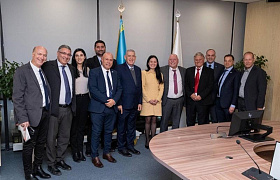
{{ $t('messages.news1') }}
The Management of Samruk-Kazyna JSC Met with a Delegation from the Sta...
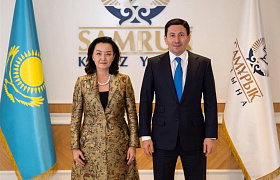
{{ $t('messages.news1') }}
Nurlan Zhakupov, Chairman of the Management Board of Samruk-Kazyna JSC...
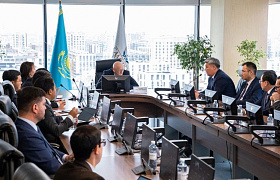
{{ $t('messages.news1') }}
Gas Industry Development: QazaqGaz to Report on Results and Projects
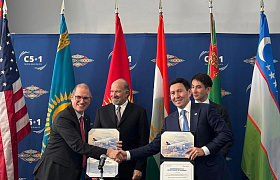
{{ $t('messages.news1') }}
A Number of Documents Signed by the Samruk-Kazyna Group during the Vis...


